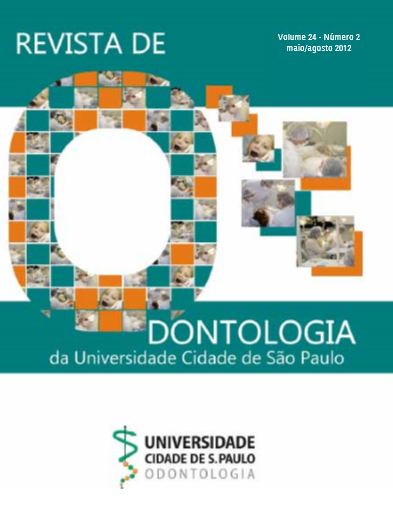Ensaio de microinfiltração: revisão da literatura
DOI:
https://doi.org/10.26843/ro_unicid.v24i2.364Palavras-chave:
Infiltração dentária, Metodologia.Resumo
A durabilidade das restaurações diretas está intimamente relacionada ao vedamento do ângulo cavossuperficial de preparos cavitários. Apesar de toda a evolução pela qual os sistemas adesivos e materiais restauradores têm passado, ainda não há perfeito selamento da interface dente-restauração. Logo, há necessidade de aprimorar as técnicas e os materiais restauradores e adesivos, com o objetivo principal de minimizar a formação de fendas marginais e consequente microinfiltração. Analisando a literatura sobre o tema, observa-se que existem diferentes metodologias para a realização do ensaio de microinfiltração. O objetivo deste trabalho é apresentar possíveis fatores que podem interferir nos resultados dese teste. Para tal fim, foi realizada uma revisão bibliográfica detalhada do tema. Conclui-se que a metodologia mais frequentemente encontrada na literatura utiliza dentes humanos com preparos cavitários de Classe V, como método de envelhecimento a ciclagem térmica, o corante azul de metileno e a leitura dos resultados feita através da análise qualitativa.Downloads
Referências
Kidd EA. Microleakage: a review. J Dent 1976 Sep;4(5):199-206.
Trowbridge HO. Model systems for determining biologic effects of microleakage. Oper Dent 1987 Autumn;12(4):164-72.
Akgungor G, Akkayan B. Influence of dentin bonding agents and polymerization modes on the bond strength between translucent fiber posts and three dentin regions within a post space. J Prosthet Dent 2006 May;95(5):368-78.
Attam K, Talwar S, Yadav S, Miglani S. Comparative analysis of the effect of autoclaving and 10% formalin storage on extracted teeth: A microleakage evaluation. J Conserv Dent 2009 Jan;12(1):26-30.
Attar N, Korkmaz Y, Ozel E, Bicer CO, Firatli E. Microleakage of class V cavities with different adhesive systems prepared by a diamond instrument and different parameters of Er:YAG laser irradiation. Photomed Laser Surg 2008 Dec;26(6):585-91.
Brackett WW, Haisch LD, Pearce MG, Brackett MG. Microleakage of Class V resin composite restorations placed with self-etching adhesives. J Prosthet Dent 2004 Jan;91(1):42-5.
Casagrande L, Brayner R, Barata JS, de Araujo FB. Cervical microleakage in composite restorations of primary teeth--in vitro study. J Dent 2005 Sep;33(8):627-32.
Celiberti P, Lussi A. Use of a self-etching adhesive on previously etched intact enamel and its effect on sealant microleakage and tag formation. J Dent 2005 Feb;33(2):16371.
Cenci M, Demarco F, de Carvalho R. Class II composite resin restorations with two polymerization techniques: relationship between microtensile bond strength and marginal leakage. J Dent 2005 Aug;33(7):603-10.
Chuang SF, Liu JK, Chao CC, Liao FP, Chen YH. Effects of flowable composite lining and operator experience on microleakage and internal voids in class II composite restorations. J Prosthet Dent 2001 Feb;85(2):177-83.
Delme KI, Deman PJ, De Moor RJ. Microleakage of class V resin composite restorations after conventional and Er:YAG laser preparation. J Oral Rehabil 2005 Sep;32(9):676-85.
Elgalaid TO, Youngson CC, McHugh S, Hall AF, Creanor SL, Foye RH. In vitro dentine permeability: the relative effect of a dentine bonding agent on crown preparations. J Dent 2004 Jul;32(5):413-21.
Fugaro OJ. COMMENTARY. Effect of prerestorative home-bleaching on microleakage of self-etch adhesives. J Esthet Restor Dent 2010 Jun;22(3):193.
Giachetti L, Scaminaci Russo D, Bambi C, Nieri M, Bertini F. Influence of operator skill on microleakege of total-etch and self-etch bonding systems. J Dent 2008 Jan;36(1):49-53.
Hegde MN, Vyapaka P, Shetty S. A comparative evaluation of microleakage of three different newer direct composite resins using a self etching primer in class V cavities: An in vitro study. J Conserv Dent 2009 Oct;12(4):160-3
Helvatjoglu-Antoniades M, Kalinderis K, Pedulu L, Papadogiannis Y. The effect of pulse activation on microleakage of a 'packable' composite resin and two 'ormocers'. J Oral Rehabil 2004 Nov;31(11):1068-74.
Kucukesmen C, Sonmez H. Microleakage of class-v composite restorations with different bonding systems on fluorosed teeth. Eur J Dent 2008 Jan;2(1):48-58.

